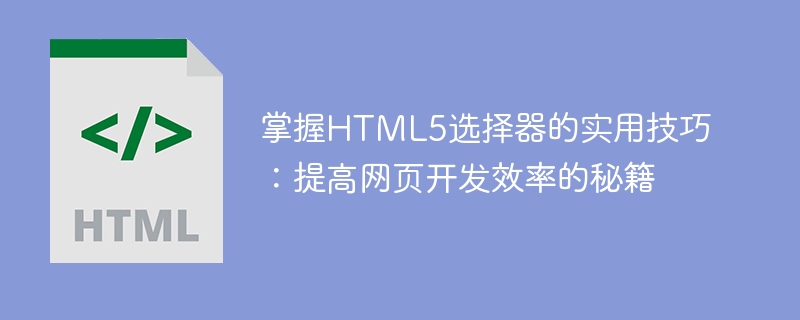

Practical tips for mastering HTML5 selectors: Tips to improve the efficiency of web development
In web development, it is very important to select elements correctly and efficiently. HTML5 selectors provide developers with many powerful and flexible tools that can greatly simplify our manipulation of web page elements. This article will introduce some practical skills of HTML5 selectors and provide specific code examples to help us better master these skills and improve the efficiency of web development.
1. Basic selector
The element selector is one of the most basic selectors. It is selected by the tag name of the element. Select the required elements. For example, to select all paragraph elements, you can use the following code:
p {
color: red;
}The class selector selects elements by adding the class attribute to the element. In CSS, class selectors start with a dot, and the same class can be used in multiple elements in HTML. For example, to select all elements with the "highlight" class, you can use the following code:
.highlight {
background-color: yellow;
}ID Selector By adding the id attribute to the element to select elements. In CSS, ID selectors start with a pound sign, and IDs should be unique in each HTML document. For example, to select an element with the ID "header", you can use the following code:
#header {
font-size: 24px;
}2. Advanced selector
The descendant selector can select descendant elements of the specified element. In CSS, descendant selectors use a space to separate two elements. For example, to select strong elements that are children of all paragraph elements, you would use the following code:
p strong {
font-weight: bold;
}Direct descendant selectors can optionally be specified The direct child of the element. In CSS, direct descendant selectors use a greater-than sign (>) to separate two elements. For example, to select the direct child element h1 under a div element, you can use the following code:
div > h1 {
color: blue;
}The sibling selector can select brothers of the same level element. In CSS, sibling selectors use a plus sign ( ) to separate two elements. For example, to select the first p element after an h2 element, you can use the following code:
h2 + p {
margin-top: 20px;
}3. Advanced selector
Attribute selector can select elements based on their attribute values. In CSS, attribute selectors can use the equal sign (=), the containing sign (*=), the opening sign (^=), and the ending sign ($=) to select elements. For example, to select all input elements whose type attribute value is "submit", you can use the following code:
input[type="submit"] {
background-color: green;
}Pseudo-class selector can select Elements in specific states, such as hover state, selected state, etc. In CSS, pseudo-class selectors are identified with a colon (:). For example, to select all hovered links, you can use the following code:
a:hover {
text-decoration: underline;
}Pseudo-element selector allows you to select a specific part of an element , such as the first letter of the element, the last letter of the element, etc. In CSS, pseudo-element selectors are identified by two colons (::). For example, to select the first letter of a paragraph element, you can use the following code:
p::first-letter {
font-size: 24px;
}The above are some practical tips for HTML5 selectors. By using these selectors properly, we can select and select more efficiently. Manipulate web page elements to improve web development efficiency. I hope this article can be helpful to all developers and further improve their web development skills.
The above is the detailed content of HTML5 Selector Tips: Tips to Save Time in Web Development. For more information, please follow other related articles on the PHP Chinese website!